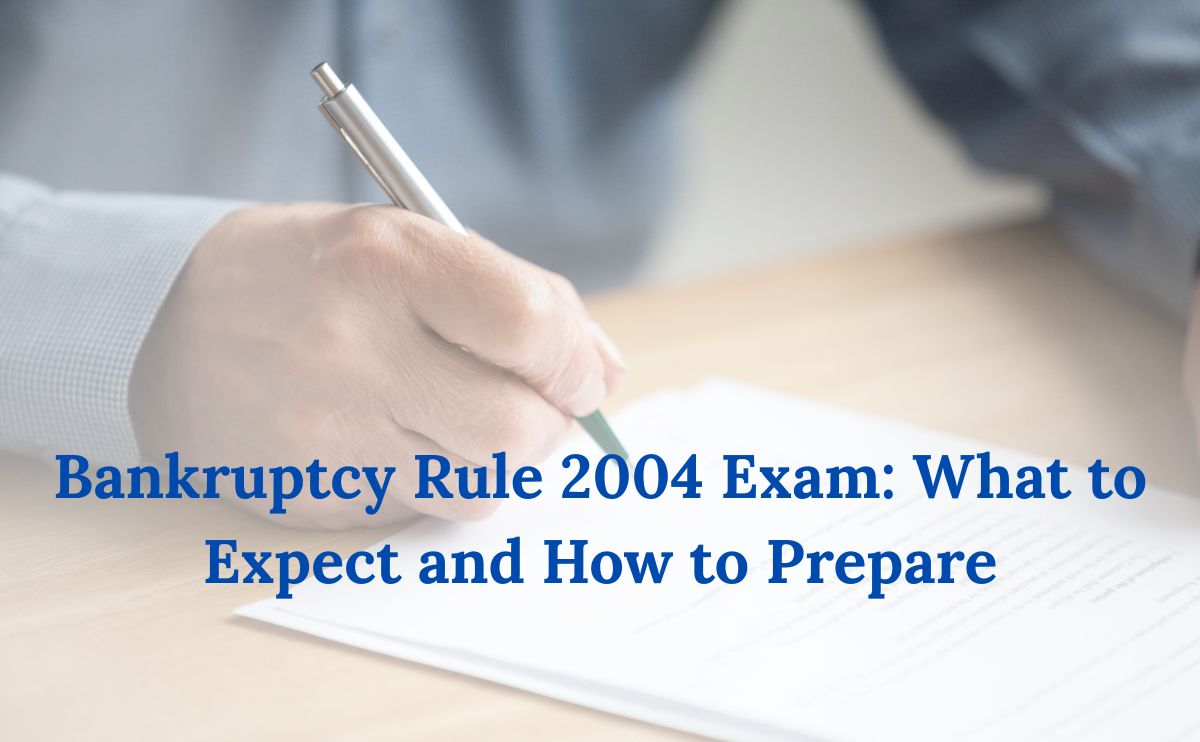Free Consultation
To discuss your financial situation and learn more about your debt relief options, give us a call at (520) 745-4429 or (480) 788-0098.
 Tucson(520) 745-4429
Tucson(520) 745-4429
 Mesa/Phoenix (480) 788-0098
Mesa/Phoenix (480) 788-0098

Filing bankruptcy can feel like stepping into a courtroom drama, and the Rule 2004 examination is one scene that often catches people off guard. This formal question-and-answer session digs deeper than the standard paperwork or the short 341 meeting of creditors.
At Yusufov Law Firm PLLC, we guide individuals in Mesa, Phoenix, and Tucson through every stage of the bankruptcy process, including the 2004 exam, so they know what to expect before the questions even begin. Today, we are sharing a clear guide to the process, why it happens, and how you can get ready.
Rule 2004 of the Federal Rules of Bankruptcy Procedure lets any interested party ask the court for permission to investigate matters tied to a bankruptcy case. The court may then order an individual or company to sit for testimony or hand over records. Compared with the usual 341 meeting, a 2004 exam is longer and far more detailed, like a deposition in civil court. Like a deposition and the 341 meeting, it is also conducted under oath.
The examination can cover nearly anything linked to the debtor’s acts, property, debts, or chance of receiving a discharge. Because the scope is broad, lawyers sometimes refer to it as a fishing expedition, but the court still expects a valid reason for casting that line.
So why do trustees or creditors seek this extra session? The main goal is information that helps them carry out their duties under the Bankruptcy Code. If the original filings leave questions about assets, transfers, or potential fraud, a 2004 exam fills the gaps. It also helps parties verify figures, trace property, and decide whether a debt should survive bankruptcy.
In many consumer cases, the 341 meeting is enough. When numbers do not add up or a last-minute transfer shows up on bank statements, a trustee may turn to Rule 2004 for answers.
The rule uses the phrase “party in interest,” a term that covers more people than many imagine.
Each requester must file a motion, explain the need, and serve notice on the person to be examined. If the target is not already part of the case, a subpoena under Civil Rule 45 is required.
Although broad, the inquiries must relate to the bankruptcy. Below are the main categories you can expect, broken down for quick review.
This area focuses on what you own, what you owe, and how you handle money.
Questions here explore behavior that may affect the case outcome.
When the debtor runs a company, Rule 2004 can dig into operations and future plans.
Understanding the steps ahead of time helps you avoid surprises.
Either side may order a copy of the transcript, which can later appear as evidence in a contested matter or adversary suit.
Despite the wide net, safeguards keep the exam from turning into harassment.
| Rule 2004 Safeguards at a Glance | |
| Protective Measure | How It Works |
| Legitimate Purpose | The moving party must show the questions tie back to the administration of the case, not personal curiosity. |
| Pending Proceeding Rule | If an adversary proceeding or outside lawsuit is already underway, discovery shifts to Civil Procedure rules, cutting off Rule 2004 fishing. |
| Objections Allowed | The examinee can challenge overly broad requests or assert claims of privilege, and the judge decides the dispute. |
| Reasonable Time & Place | The court can adjust dates or locations to prevent undue burden, especially for out-of-state witnesses. |
The takeaway: a 2004 exam is a powerful tool, yet not unlimited. If you believe questions stray too far, raise privacy issues, or duplicate existing litigation, your lawyer can object.
A little advance work eases stress and shortens the session.
Arriving organized shows you have nothing to hide and helps the examiner finish faster.
Facing a 2004 exam without guidance can feel like being called to the witness stand without a script. Our team at Yusufov Law Firm helps clients assemble documents, prepare testimony, and attend the session to guard against irrelevant or abusive questioning. We have handled exams for individuals and businesses, so we know the common pitfalls and how to avoid them.
If your trustee or a creditor has filed a motion for a Rule 2004 exam, or you suspect one is coming, act now. Fast action often narrows the scope or resolves concerns before the examination date.
Questions are welcome. Call us at 520-745-4429 (Tucson) or 480-788-0098 (Phoenix/Mesa), or visit our Contact Us page to set up a consultation. We look forward to helping you move toward a fresh financial start with confidence.
To discuss your financial situation and learn more about your debt relief options, give us a call at (520) 745-4429 or (480) 788-0098.
© 2010-2025 Yusufov Law Firm PLLC. All Rights Reserved | Disclaimer | Sitemap |